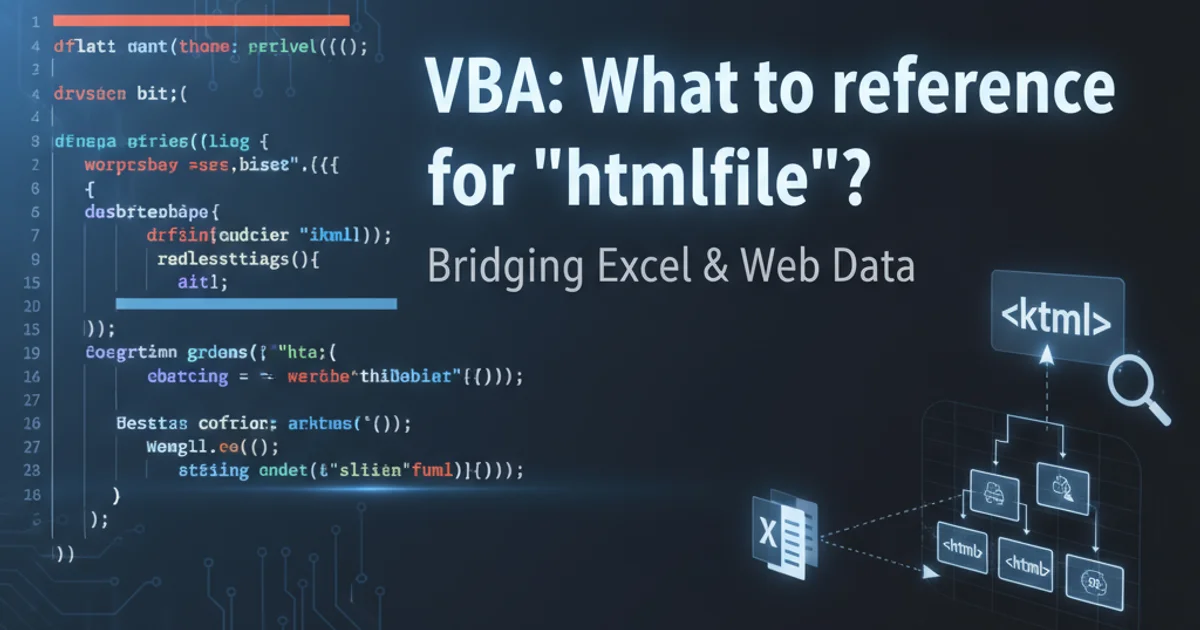VBA: What to reference for "htmlfile"?
Categories:
VBA: Referencing the 'htmlfile' Object for Web Scraping and DOM Manipulation

Learn how to properly reference and utilize the 'htmlfile' object in VBA for powerful web scraping, HTML parsing, and DOM manipulation tasks within your Excel or Access applications.
When working with VBA to interact with web content, such as parsing HTML documents or scraping data from websites, the htmlfile object is an indispensable tool. It allows you to load HTML strings or entire web pages into a memory-resident Document Object Model (DOM) and then manipulate it using standard DOM methods and properties. However, to use htmlfile, you must first establish a reference to the correct library. This article will guide you through the necessary steps and provide practical examples.
Understanding the 'htmlfile' Object
The htmlfile object is part of the Microsoft HTML Object Library, which provides programmatic access to HTML elements and their attributes. It's essentially an in-memory representation of an HTML document, allowing you to treat HTML as a structured collection of objects (elements, attributes, text nodes) that can be navigated, queried, and modified. This is crucial for tasks like:
- Web Scraping: Extracting specific data points from web pages.
- HTML Parsing: Analyzing the structure and content of HTML documents.
- Dynamic Content Generation: Creating HTML content programmatically.
- Form Automation: Filling out and submitting web forms.
flowchart TD
A[Start VBA Macro] --> B{"Need to interact with HTML?"}
B -->|Yes| C[Open VBA Editor (Alt+F11)]
C --> D[Go to Tools > References...]
D --> E["Check 'Microsoft HTML Object Library'"]
E --> F[Click OK]
F --> G[Declare 'htmlfile' Object]
G --> H[CreateObject("htmlfile")]
H --> I[Load HTML Content]
I --> J[Parse/Manipulate DOM]
J --> K[Extract Data/Modify HTML]
K --> L[End VBA Macro]
B -->|No| LWorkflow for referencing and using the 'htmlfile' object in VBA
Referencing the Microsoft HTML Object Library
Before you can declare and use an htmlfile object, you must enable the 'Microsoft HTML Object Library' in your VBA project. This library contains the definitions for the HTMLDocument interface (which htmlfile implements) and other related HTML elements.
Here's how to add the reference:
1. Open the VBA Editor
In your Excel, Access, or other Office application, press Alt + F11 to open the Visual Basic for Applications editor.
2. Access References
From the menu bar in the VBA editor, go to Tools -> References....
3. Locate and Select the Library
In the 'References - VBAProject' dialog box, scroll down the list until you find 'Microsoft HTML Object Library'. Check the box next to it. The version number might vary (e.g., 2.0, 4.0), but the name will be consistent.
4. Confirm Selection
Click OK to close the dialog box and apply the reference. Your VBA project can now recognize and use objects from this library.
Instantiating and Using the 'htmlfile' Object
Once the reference is set, you can declare and create an instance of the htmlfile object. You typically use CreateObject("htmlfile") to instantiate it, which returns an HTMLDocument object. You can then load HTML content into it using its body.innerHTML property or by navigating to a URL (though for direct web scraping, MSXML2.XMLHTTP is often used to fetch the HTML first).
Sub UseHtmlFileObject()
' Declare an HTMLDocument object
Dim htmlDoc As HTMLDocument
' Create an instance of the htmlfile object
Set htmlDoc = CreateObject("htmlfile")
' Load some HTML content into the document
htmlDoc.body.innerHTML = "<html><body><h1>Hello, VBA!</h1><p id='myPara'>This is a paragraph.</p></body></html>"
' Now you can interact with the DOM
Dim heading As Object
Set heading = htmlDoc.getElementsByTagName("h1")(0)
Debug.Print "Heading Text: " & heading.innerText
Dim paragraph As Object
Set paragraph = htmlDoc.getElementById("myPara")
Debug.Print "Paragraph Text: " & paragraph.innerText
' Clean up
Set htmlDoc = Nothing
End Sub
Basic example of creating an 'htmlfile' object and parsing HTML content
htmlfile is excellent for parsing HTML strings, for fetching HTML directly from a URL, it's common practice to combine it with MSXML2.XMLHTTP (for making HTTP requests) or InternetExplorer.Application (for full browser automation). The htmlfile object then takes the fetched HTML string as input.Common Pitfalls and Troubleshooting
While generally straightforward, you might encounter issues:
- 'User-defined type not defined' error: This almost always means you haven't set the reference to 'Microsoft HTML Object Library'. Double-check
Tools > References.... - Runtime error '429': ActiveX component can't create object: This can happen if the necessary COM components are not registered or are corrupted. Re-registering
mshtml.dll(often located inC:\Windows\System32) viaregsvr32 mshtml.dllfrom an elevated command prompt might help, but proceed with caution. - Incorrect parsing: Ensure the HTML you're feeding to
htmlfileis well-formed. Whilehtmlfileis somewhat forgiving, malformed HTML can lead to unexpected DOM structures. - Dynamic content:
htmlfileprocesses static HTML. If a webpage loads content dynamically via JavaScript after the initial page load,htmlfilealone won't see it. For such cases, full browser automation withInternetExplorer.Application(or Selenium Basic) is required.